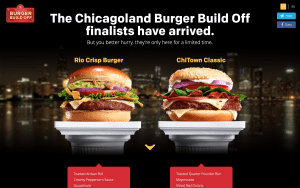By Vicki Matranga
Design Programs Coordinator
Social media has changed business and culture rapidly in just a few years. Makers and sellers of new products and services spot trends and track consumers’ preferences via numerous social platforms. Today we are speaking with four designers who are influenced by the same developments. They give us their views on how social media has changed their work as they create the products that respond to consumers’ conversations.
We’ll hear from Lisa Yanz Lehman, associate design director of the Brooklyn-based PENSA design consultancy; Kaitlyn Benoit, industrial designer for KitchenAid small appliances at Benton Harbor, Mich.-based Whirlpool; industrial designer April Starr, faculty at the Illinois Institute of Technology’s Institute of Design in Chicago; and Peter Rivera-Pierola, Manager, Retail Experience, U. S. Restaurant Design at McDonald’s USA.

What is the most exciting or rewarding part of your work?
Lisa: As a design consultant, it is really great to work on such a wide range of projects with very different types of companies. There is always a new challenge to tackle. It is inspiring to take all of these experiences and connect the dots between them.
Kaitlyn: I am very lucky to be a designer for KitchenAid Small Appliances, one of the most iconic brands in the industry. It’s not often that designers have the opportunity to work for brands with both a strong history and a bright future. Our design team gets to build and maintain the brand through product development around our iconic stand mixer while also to delving into new categories and innovate in those spaces.
![]()
Another rewarding aspect of designing for KitchenAid is our brand’s global presence. KitchenAid sells product all over the world and our Michigan-based designers spend a lot of time traveling to learn about food culture and developing products for other regions. We also spend time working with and at our foreign suppliers. These experiences really enhance our understanding of those cultures and help create authentic, quality products.
Peter: The potential to influence at such a grand scale is what drives our talented and passionate team to come to work every day—what may start out as a tiny idea can become a system-wide initiative in a matter of months with the right conditions. I’m inspired by a balanced user-centered approach: creating solutions our customers’ desires, by means that are feasible, that make business sense for our company.

April: I guide students through the process of designing large-scale, multi-channel, dynamic service systems. I’m attuned to observing inefficiencies and unnecessarily complexity and I get frustrated. This frustration fuels my passion to make things better. I am also intensely curious about people—why do they do the things they do?
In the past few years, what has changed most in your business? How has your company met these challenges in the way you do your work?
Lisa: In a design consultancy we are always evolving the way we approach clients and specific projects. In recent years we have been engaged by more small startups and have approached development with them in a very iterative and collaborative way.
Kaitlyn: Speed. The world is moving faster and the share and exchange of information opens up new paths. Everyone in the industry is getting faster and smarter. We’ve gotten smarter about the way we work and collaborate on a global scale and also about how we can use technology and new communication tools to our advantage.
We’ve also gotten a lot faster and enjoyed some great successes in the market. A great example of this is our new KitchenAid Spiralizer attachment. This project started as a tool to peel, core and slice apples. Early in the product development cycle, we identified the spiralizing trend and realized we could incorporate that functionality into our apple peeling attachment. The early identification of the trend and a very efficient development cycle allowed us to launch our attachment in June of 2015 at the height of the spiralizing trend. It’s been a huge hit in the market. With trends like this, timing and speed can result in selling a large volume of product and gaining a piece of the pie.

Peter: Our company has taken a renewed focus on the customer over the past couple years, making the work we do ever more important. Our leadership is adamant about signaling change to our customers, and proving that we’ve been listening to their feedback. This is especially true in our latest restaurants, where we’ve modernized the environment, service, and product to deliver on this promise. These efforts have made our company smaller by breaking down silos and strategically aligning our collective objectives.
April: The explosion of data sources—social media, sensors and behavioral data exhaust—make it even more difficult to identify what’s really useful and important. Thankfully there are a number of approaches to discern the signal from the noise and if people attend the panel discussion conversation they can learn more about them.
How Social Media is Changing Design
Lisa Lehman, Kaitlyn Benoit, April Starr and Peter Rivera-Pierola
Innovation Theater, Lakeside Center, Room E350
March 7, Monday 3:30 – 4:20 pm
Tell us what you will be speaking about and how and this topic is important for Show audiences.
Lisa: We are going to delve into the topic of how social media isn’t just a tool for connecting with your customer, but actually learning how to better design for your customer. There is a wealth of information available online in the form of online consumer reviews, sharing/recommendations and curation of customers’ interests. There are also tools that help designers share with each other and get inspired in new ways. We are looking to have a conversation about how to harness and interpret these tools to design better products and experiences.

Kaitlyn: This is an opportunity to reflect on the way that social media is affecting us. We are so immersed in the world of social media, it’s good to take a step back and think about the effects, the trends and how we can leverage it moving forward. I mentioned ‘speed’ earlier as a key factor to success in the market and social media has an interesting tie to ‘speed’ because it’s often the fastest, most raw source of information. This, of course, means the information may not always be truthful, but the real-time, unedited nature of it is really intriguing.
April: I mostly work with organizations that deliver services primarily with digital touchpoints. The Show is a great opportunity to share what I’ve learned with organizations that are more physical product-oriented. I think we are finally at a time where traditional static product companies are realizing the opportunity to think holistically—developing marketing strategies simultaneously with products, wrapping products with services, embedding sensors to create products that will evolve with people. These initiatives all require having solid insights about people—how they will use the product and how will it fit into their lives.
Peter: I will be talking about how McDonald’s has leveraged social media to initiate, collaborate, and evaluate the work that we do. This is important because social media may prove to be a better metric for measuring design success than something like ROI or sales alone. It captures the more intangible benefits of an experience, through a more passionate niche of influential people, with greater exposure and potential for capital gains. Key examples include:
-
 New packaging. First inspired by the social media #lovin campaign and accompanying fun, app-icon-like illustrations, the latest iteration focuses on bold, colorful typography to work alongside our increasingly modern restaurants and upcoming mobile app. The packaging even inspired a couture fashion collection from students at Miami International University of Art and Design.
New packaging. First inspired by the social media #lovin campaign and accompanying fun, app-icon-like illustrations, the latest iteration focuses on bold, colorful typography to work alongside our increasingly modern restaurants and upcoming mobile app. The packaging even inspired a couture fashion collection from students at Miami International University of Art and Design.
- Burger Build Off. Leveraging the momentum of our new custom burger platform in test across the globe, we asked Chicago to build an iconic burger using any combination of ingredients stocked in our kitchens. The contest was optimized for use across screens and devices, encouraging collaboration towards a truly localized product.

- YouTube Experience Review. Last fall, we quietly launched several of our new progressive
restaurant concepts in select New York City sites to test customer reaction. We were pleasantly surprised by the generally positive and candid responses, especially from popular YouTube vlogger Casey Neistat—he proceeded to narrate his entire restaurant experience, commenting on the order process, environment, table service, and food.
What do you see as consumers’ biggest concerns regarding housewares products?
Kaitlyn: I think consumers’ biggest concerns vary greatly depending on their personal interests and values. At KitchenAid, we focus on consumers who love to be in the kitchen using their small appliances and tools to create beautiful meals. These consumers are concerned about having a quality product that will allow them to perfect their craft. They expect it to last for a long time. They expect quality materials and construction and something that is easy to use and easy to clean. Today’s consumers are becoming a lot pickier and more sophisticated in their tastes. As a designer, I think that’s a good thing. It gives us a longer runway to make beautiful, quality products for them.
Peter: Hitting critical mass I think. While there’s always room for several players in a given market, consumers end up losing out when the industry cannot make up its mind, as in “The Paradox of Choice”. Too many choices lead to anxiety, and betting on the wrong horse can be frustrating for the early adopters. That’s why I personally love review sites like thesweethome.com and thewirecutter.com; they help me navigate the mass sea of choice and get to the cream of the crop.
April: People are trending towards a more minimalist lifestyle so selecting the appropriate products for their lives is seen more as an investment. The selection process has become more complex both because of the amount of options available but the information sources to research these products.
What are some of today’s trends or issues that new product development professionals and/or retailers face in the housewares market?
 Peter: There’s been an interesting ebb and flow along the spectrum of manual/artisanal to automatic/modern. Just when I think we’ve swung all the way to one side, the next cool product comes out and balances the scale. Much of this positioning is determined by industry or demographic, but it’s nonetheless interesting to track and understand.
Peter: There’s been an interesting ebb and flow along the spectrum of manual/artisanal to automatic/modern. Just when I think we’ve swung all the way to one side, the next cool product comes out and balances the scale. Much of this positioning is determined by industry or demographic, but it’s nonetheless interesting to track and understand.
Another key trend is how every product is now part of a greater ecosystem or service. Being a systemic designer, this makes sense to me as no product exists in a vacuum. In fact, many products either succeed or fail based on the quality of their software. But let’s also proceed with discipline and intention; not everything needs to be an Internet of Things (IoT). “Dumb” things can actually be quite nice.
Kaitlyn: I would say early identification of trends and correct identification of consumer needs. In order to develop a product in time to hit the trend, you really need to be at the forefront of trend identification. This takes dedicated attention and a special knack for identifying what will be a good business opportunity. Correctly identifying consumer needs is also key. If you have enough capital, anyone can make a product. Making a great product requires insightful identification of trends and consumer needs and an elegant, compelling product solution.
That being said, I think those of us in the housewares industry are really very lucky to be in our industry right now – food and dining are enjoying such a golden age and we have the opportunity to be right in the middle of it and to drive it forward.
Thank you, Lisa, Kaitlyn, Peter and April, for your insightful conversation! We look forward to hearing you discuss the value of social media from a designer’s perspective on Monday March 7 at 3:30pm in the Innovation Theater, Lakeside Center, room e350.
To learn more about the speakers, visit:
Lisa Yanz Lehman
Associate Design Director
Pensa
llehman@pensanyc.com
www.pensanyc.com
Kaitlyn Benoit
KitchenAid Small Appliances
Whirlpool Corporation
kaitlyn_m_benoit@whirlpool.com
www.WhirlpoolCorp.com
April Starr
Researcher/Educator
IIT/Institute of Design
www.id.iit.edu
aprilstarr@gmail.com
Peter Rivera-Pierola
Manager, Retail Experience
U.S. Restaurant Design
McDonald’s USA LLC
Peter.Rivera-pierola@us.mcd.com
Innovation propels the housewares industry. Learn from experts about how to develop and launch new products and services to better reach your customers. Critical issues such as global design trends, the emerging Internet of Things (IoT) category, omni-channel retailing, branding, the needs of distinct consumer age groups, the future of food and more – all impact the home goods market.



